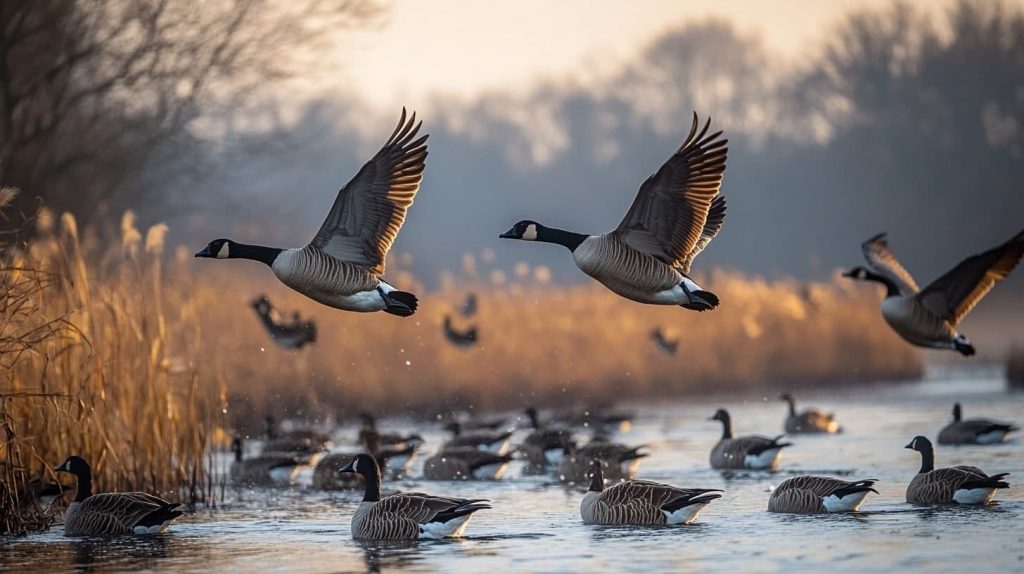Goose hunting is a cherished tradition in America, combining strategy, skill, and a deep connection to nature. Whether you’re a seasoned hunter or new to the sport, understanding the nuances of goose hunting is vital to a successful and enjoyable experience. From regional differences and migratory patterns to legal regulations and advanced techniques, this guide delves into the critical elements of goose hunting across the United States.
The American Landscape and Goose Migration
The United States is home to a variety of geese species, including Canada geese, snow geese, and specklebelly geese. Each species has distinct behaviors and migratory patterns, which hunters must consider. Geese migrate along four primary flyways in North America: the Atlantic, Mississippi, Central, and Pacific flyways.
Timing your hunt to coincide with peak migration is critical. Early mornings are generally the best time to hunt, as geese are most active during this period, leaving their roosts to feed. Late-season hunts can be especially rewarding, as geese become less cautious and often travel in larger flocks.
The Role of Scouting and Location
Scouting is the foundation of any successful goose hunt. Identifying feeding and roosting areas, as well as travel routes, allows hunters to anticipate goose movements. Key indicators of prime locations include open water, agricultural fields, and undisturbed wetlands.
Public lands and wildlife management areas across the country provide excellent opportunities for goose hunting. However, private lands often hold the best hunting spots. Building relationships with landowners or leasing hunting rights can grant access to these coveted locations.
Understanding Legal Regulations
Before embarking on a goose hunt, it is essential to familiarize yourself with state and federal regulations. Goose hunting in the United States is tightly regulated to ensure sustainable populations and ethical practices. Key considerations include:
- Hunting Licenses: Most states require both a state hunting license and a federal migratory bird hunting and conservation stamp (commonly known as a duck stamp).
- Bag Limits: Bag limits vary by species and region, so check local guidelines before your hunt.
- Shooting Hours: Many states restrict shooting to daylight hours, typically from 30 minutes before sunrise to sunset.
Following these regulations not only ensures a legal hunt but also contributes to the long-term conservation of waterfowl populations.
Gear and Equipment Essentials
Successful goose hunting requires the right equipment. Key items include:
- Shotguns and Ammunition: A 12-gauge shotgun with non-toxic shot is the standard choice. Opt for steel, bismuth, or tungsten to comply with federal regulations.
- Decoys: Realistic decoys are essential for luring geese into shooting range. Full-body, silhouette, or shell decoys work well, depending on the hunting environment.
- Calls: Goose calls mimic the natural sounds of geese and are critical for attracting flocks. Mastering these calls requires practice and an understanding of goose behavior.
- Blinds: Concealment is crucial when hunting geese. Layout blinds or natural cover help hunters remain undetected.
Proper clothing is also vital. Waterproof and insulated gear keeps hunters comfortable during cold, wet conditions, while camouflage patterns help blend into the surroundings.
Mastering Decoy Placement
Decoy placement is both an art and a science. The arrangement of your decoys can significantly influence your success. Popular formations include the “U,” “J,” or “X” shape, which create natural landing zones for incoming geese.
Adjust your setup based on wind direction, as geese prefer to land into the wind. Keep decoy spacing irregular to mimic the natural behavior of feeding geese. Experiment with motion decoys, such as flagging or spinning-wing devices, to add realism and attract attention from afar.
Calling Techniques for Success
Goose calls are an invaluable tool for hunters, but their effectiveness depends on timing, volume, and tone. Common calls include the honk, cluck, and moan, each serving a specific purpose:
- Honk: Used to gain the attention of distant flocks.
- Cluck: A soft, conversational call to reassure geese as they approach.
- Moan: A low-pitched call that mimics contented geese feeding on the ground.
Overcalling can spook wary geese, so balance is key. Pay attention to the behavior of incoming birds and adjust your calling accordingly.
Overcoming Challenges
Goose hunting presents unique challenges, from unpredictable weather to the keen eyesight of geese. Patience and adaptability are critical. If geese are flaring (flying away before entering shooting range), reevaluate your setup. Common issues include poorly concealed blinds, unnatural decoy arrangements, or improper calling techniques.
Conservation and Ethical Hunting
Ethical hunting practices ensure the future of waterfowl populations and preserve the integrity of the sport. Responsible hunters prioritize clean kills by taking ethical shots within effective range. Supporting conservation efforts, such as wetland restoration or donating to organizations like Ducks Unlimited, also contributes to healthy ecosystems.
Conclusion
Goose hunting in America is a rewarding pursuit that combines strategy, skill, and respect for nature. By understanding the nuances of migration patterns, regulations, and hunting techniques, you can enhance your chances of success while contributing to the conservation of waterfowl habitats. With preparation, patience, and a commitment to ethical practices, goose hunting can provide unforgettable experiences and cherished memories.
